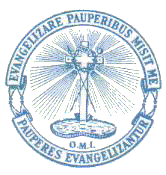
The History

What does OMI mean?
It means Oblates of Mary Immaculate, the seventh largest congregation of men in the world. It was founded by St. Eugene de Mazenod who was born into a wealthy and influential family of France on August 1, 1782.
He gathered together priests to take care of the poor and the most abandoned. Later, this group was named Oblates of Mary Immaculate. Pope Leo XII approved this Religious Congregation taking on the motto:
"He has sent me to bring
the good news to the poor.
The poor have the good
news brought to them."
There are nearly 7,000 OMI's in almost 70 countries. They are present in the vast wastes of Canada, in the howling winds of the North Pole, in the hot regions of Africa, in the war-torn countries of Latin America, the impoverished countries of Asia, and in the industrialized countries of Europe and America. Pope Pius XI was so impressed by the daring spirit of the OMI missionaries that he named them:
"Specialists in the most difficult missions of the Church".
The first "magnificent seven" OMI Missionaries arrived in the Philippines in 1939. They were assigned to the most difficult and dangerous provinces of Cotabato and Sulu. A Manila-based journalist who visited the OMI missions once referred to them as the "Commandos of the Philippine Church".


